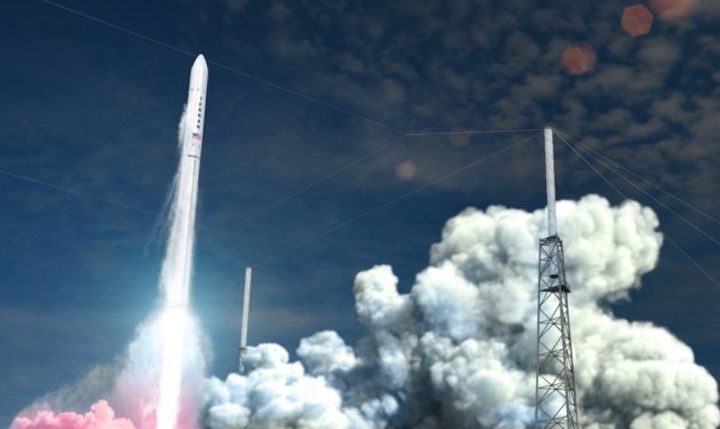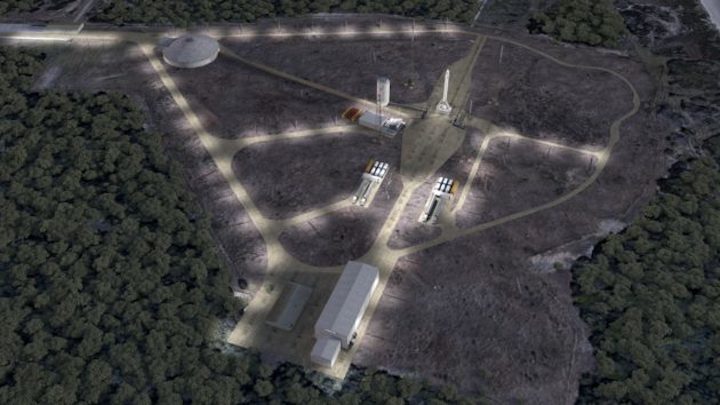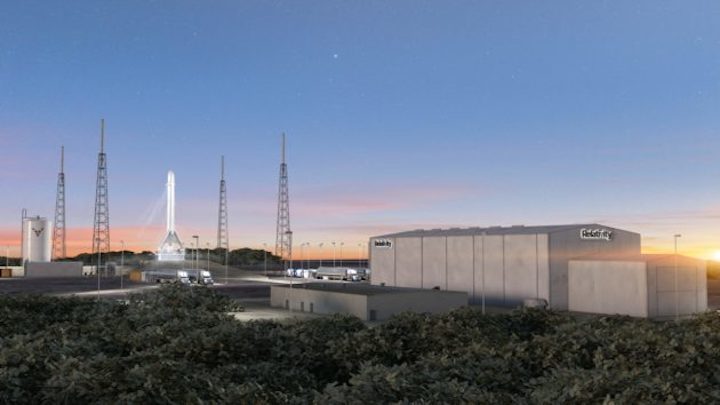19.01.2019

Relativity Space, the California-based rocket startup that got its start in Seattle, has won Air Force clearance to build its Florida launch facility on a site that saw service during NASA’s Apollo and Gemini programs in the 1960s.
The agreement gives Relativity Space exclusive use of Cape Canaveral Air Force Station’s Launch Complex 16 — which was first used for Titan missile launches, and then for Gemini crew processing and static firing tests of the Apollo service module’s propulsion engine under NASA’s supervision.
After Apollo, the site was returned to the Air Force and used for test-firing Pershing ballistic missiles. Launch Complex 16 has been largely dormant since the Pershing program was deactivated in 1988 to comply with the U.S.-Soviet Intermediate-Range Nuclear Forces Treaty.
Veteran aerospace executive Tim Buzza, an adviser who came to Relativity Space after working for SpaceX and Virgin Orbit, said there’s little left today that existed during the launch complex’s glory days — only a round blockhouse, a covered walkway and a ramp to the launch platform.
“There isn’t anything historical that’s been brought up to us,” Buzza told GeekWire.
The roughly 18-acre site is thus a blank slate that Relativity plans to improve. It’ll add an integration hangar, an engineering and support building, a payload processing facility, propellant storage tanks and everything else that’s needed to start launching the company’s 3-D-printed Terran 1 rockets by the end of next year.

This artwork shows Relativity Space’s vision for Launch Complex 16. (Relativity Space Illustration)

Relativity’s five-year agreement, with an option to extend to 20 years, puts the four-year-old venture in elite company: Only SpaceX (Launch Complex 40), Blue Origin (LC-36) and United Launch Alliance (LC-37 and LC-41) have similar arrangements for a major operational orbital launch site on the Air Force’s prime East Coast launch grounds.
The company was founded in Seattle in 2015 by CEO Tim Ellis, a former Blue Origin engineer; and chief technology officer Jordan Noone, a former SpaceX engineer. It quickly relocated to Los Angeles. Over the past nine months, the venture has grown from a team of 14 to about 60 employees, including a dozen senior leaders from the likes of SpaceX, Blue Origin, Virgin Orbit and Tesla.
That growth has been fueled by more than $45 million in investment, with billionaire entrepreneur Mark Cuban, Playground Global, Y Combinator and Social Capital among Relativity’s leading backers.
The L.A. headquarters is home to a huge 3-D printer, nicknamed Stargate, that can produce metal parts for Relativity’s Aeon 1 rocket engine and Terran 1 rocket.
Last year, the company reached an agreement with NASA to use an engine test complex at NASA’s Stennis Space Center in Mississippi. Buzza said Relativity has been at work on the site, but the partial government shutdown is having an impact.
“Unfortunately, some of the interaction that we’ve been having has come to a halt,” he said.
Relativity’s plan calls for hardware to be built in Los Angeles, tested at Stennis and launched from Cape Canaveral. The methane-fueled, two-stage Terran 1 is designed to loft up to 1,250 kilograms (2,750 pounds) of payload into low Earth orbit, at an estimated cost of $10 million.
The company says it has hundreds of millions of dollars’ worth of tentative launch commitments but hasn’t yet identified those potential customers. Buzza said the development schedule is still on track to execute the first test launch by the end of 2020, with three commercial launches on the manifest for 2021.
Buzza and his Relativity teammates wanted to get the Cape Canaveral deal done first, but they’re also working on securing a launch facility at Vandenberg Air Force Base in California for missions that call for polar and sun-synchronous orbits.
“We’re probably two to four months away from being at this stage on the Western Range,” Buzza said.
Quelle: GeekWire
+++
Aerospace startup making 3D-printed rockets now has a launch site at America’s busiest spaceport
Relativity Space has the infrastructure; now it just needs to build the rocket
America’s busiest spaceport in Cape Canaveral, Florida, is about to get a new tenant: a startup that shares SpaceX’s ambitious plans of turning humans into a multiplanetary species. The new occupant is LA-based launch provider Relativity Space, a company that wants to revolutionize how rockets are manufactured through the use of fully automated 3D printing. The company will soon have its very own launch site at the Cape for its future 3D-printed vehicles.
Thanks to a new deal with the US Air Force, Relativity will be taking over a site at Cape Canaveral Air Force Station called LC-16. It’s a pad that was once used by the US military to launch Titan and Pershing ballistic missiles. But since the late 1980s, LC-16 has been dormant. The Air Force picked Relativity to move into the area after a very competitive bidding process, and the company will modify the pad to suit its rocket technology. “Getting the launch site agreement was a huge checkmark,” Tim Ellis, co-founder and CEO of Relativity Space, tells The Verge. “That was the final infrastructure piece we need to have a clear path toward launching.”
Over the last year, Relativity has quickly established itself as a serious player in the commercial space industry. The company, which was founded in 2016, has raised more than $45 million in funding. It also has multiple workspaces in Los Angeles, and it’s currently using facilities at NASA’s Stennis Space Center in Mississippi to test the Aeon engine it’s been working on. As of now, Relativity has done 124 test fires of its rocket engine, in pursuit of launching the company’s first rocket by 2020.
:no_upscale()/cdn.vox-cdn.com/uploads/chorus_asset/file/13696620/RR_OnPad.4k1_2.jpg)
That vehicle will be called the Terran 1, a nod to the human explorers in the computer game Starcraft. It won’t be terribly large, either: at about 10 stories tall, the rocket will be a small- to medium-sized launcher that’s capable of putting about 2,755 pounds (1,250 kilograms) into low Earth orbit, which is about the same weight as a Honda Civic. That’s a small load compared to the 50,000 pounds (22,800 kilograms) that SpaceX’s Falcon 9 can carry to orbit. But Ellis says the real groundbreaking aspect of the vehicle will be in how it’s made.
Relativity’s goal is to disrupt the entire process of manufacturing rockets. “For the last 60 years, the way rockets have been built hasn’t really changed,” says Ellis. Instead of relying on the traditional, complicated assembly line of machines and people sculpting and piecing together parts of a vehicle, Relativity wants to make building a rocket almost entirely automated. The trick? Using giant 3D printers that can create all of the parts needed to build a rocket — from the engines to the propellant tanks and structure.
At the company’s Los Angeles headquarters, Relativity has the largest metal 3D printer by volume, a machine that’s capable of creating parts that are up to 20 feet tall and 10 feet wide. It’s called Stargate, another nod to Starcraft, and the team designed this printer from scratch, which means they can scale it up if needed. Ellis says that by relying on printers like this for manufacturing, the team will be able to produce about 95 percent of the rocket through 3D-printed automation. The last 5 percent still requires human labor. Most of that human interaction will be centered on testing, shipping, and very small amounts of manual assembly.
:no_upscale()/cdn.vox-cdn.com/uploads/chorus_asset/file/13696624/Stargate_5.jpg)
Building rockets this way is meant to serve two purposes for the company. First, it’s meant to save money by consolidating the parts needed for each vehicle. Ellis says that the 3D printer they’ve developed can make incredibly complicated parts in just one piece, and he argues Relativity will be able to produce rockets with 100 times fewer parts than normal. For instance, Relativity’s engine injector and chamber are made of just three 3D-printed parts; traditionally, such sections would require nearly 3,000 parts, says Ellis. “All the complexity is really in the software,” he says. “It’s really what the file and CAD model looks like. The 3D printer doesn’t really care how complex it is. It’s able to make shapes of almost any complexity.”
The team can also quickly adjust the design if needed, simply by changing the software. And 3D printing will allow the company to simplify the manufacturing process, shortening the time it takes to build each rocket. Ellis says the goal is to get to a point where it only takes 60 days to manufacture one vehicle. “We’ll be able to achieve that because of the robotic automation and 3D-printing technologies,” he says.
If all of this works out, Relativity will try to realize its more ambitious long-term goal: taking this manufacturing process to the Red Planet and building a rocket using 3D printers on Mars. Ultimately, Relativity wants to establish a construction business on our planetary neighbor, along with launching rockets here on Earth. “I really view us as having two products,” says Ellis. “One is the rockets, the other is the factory.”
Ellis, a former propulsion engineer at Blue Origin, says he was inspired by SpaceX’s core mission to start a settlement on Mars. But he thought there needed to be at least dozens or hundreds of companies working on Mars technologies to make that vision for the future a reality. To illustrate his point, he refers to one of SpaceX’s animations, which shows the company’s future Mars rocket, the Starship, landing on the Red Planet’s surface. “The door opens and the astronauts get out, and there’s just nothing there,” he says. “There really needs to be a company that’s actually going to work on the build technology.”
:no_upscale()/cdn.vox-cdn.com/uploads/chorus_asset/file/13696632/Aeon_Test_SN006.jpg)
That’s where Relativity hopes to come in. Once it masters its automation process here on Earth, the company hopes to shrink its printers and ship them to Mars via rockets to see if they can create vehicles capable of launching from the Red Planet using raw metallic materials. If successful, Relativity could provide a service that both scientists and engineers have dreamed about for decades: a way to leave Mars once you get there. So far, we’ve only ever been able to land hardware on Mars, but not bring it back. Being able to launch from Mars would be useful for getting humans off the planet or even collecting samples of Martian rocks in order to return them to Earth for study. Ellis says that the company has already piqued the curiosity of NASA, which hopes to bring samples of Mars to Earth someday.
For now, Relativity is focused on proving that it can build and launch rockets from Earth in this newly automated way, and it has a fairly credible team working toward that goal. The company has grown to a team of 60 people, 12 of which are already well-respected leaders in the private spaceflight industry. That includes Tim Buzza, one of SpaceX’s earliest engineers. The company has also raised all of its funding purely through venture capital. So with this new deal announced today, Relativity is the first venture-backed launch company to set up shop at Cape Canaveral Air Force Station, which also hosts aerospace giants like SpaceX, Blue Origin, and the United Launch Alliance.
Customers seem to be excited about what Relativity has to offer. Ellis says the company has garnered a little more than $1 billion in potential contracts from customers, and with the new launch site, it’s building out a manifest of future launches. The team is also collaborating with NASA on new propulsion capabilities.
In the end, though, Ellis hopes the success of Relativity serves as an inspiration for other companies to work on technologies needed for Mars. Perhaps other organizations might want to work on new remote energy generation or mining technologies that could be used on both our planet and the one next door. “I hope we inspire 12 or 100 companies to want to go to Mars and do the same mission,” says Ellis. “And then we all work on different parts of this. That’s really the vision to me.”
Quelle: The Verge
